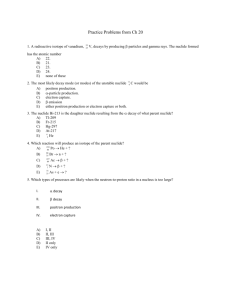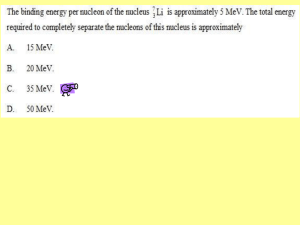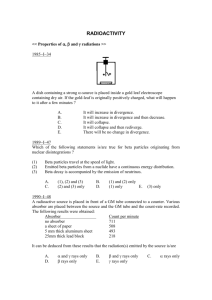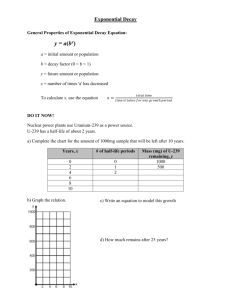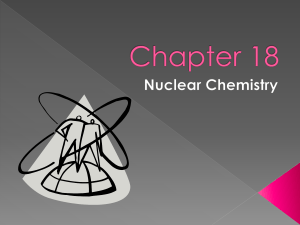Radioactivity and Decay - Review Question 39
advertisement
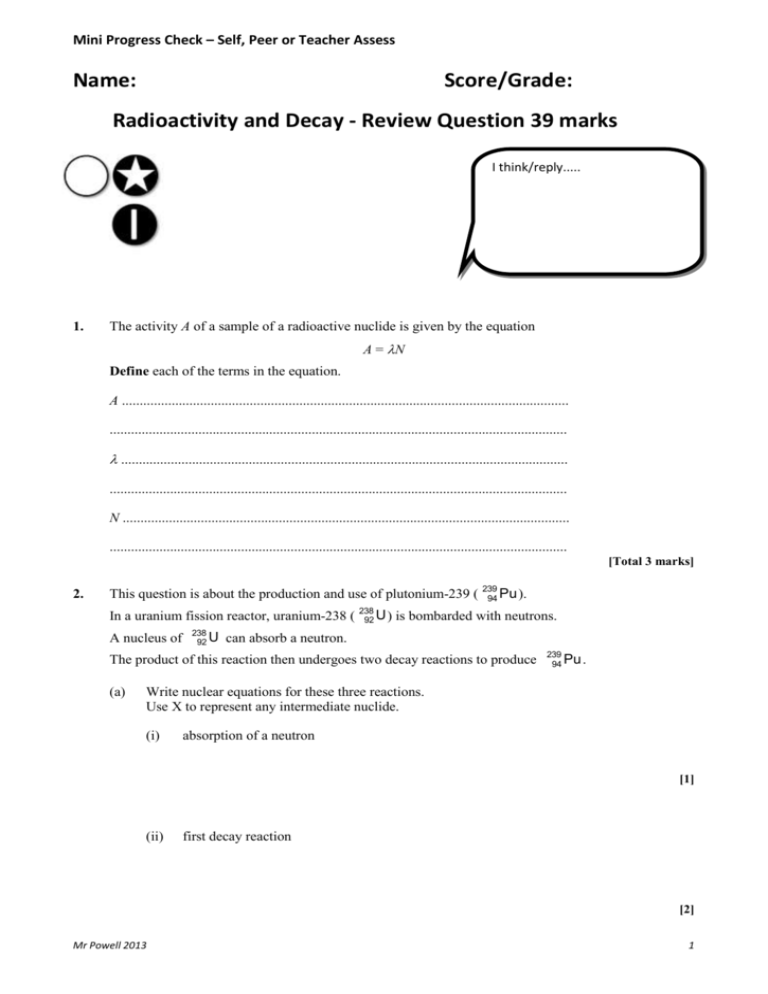
Mini Progress Check – Self, Peer or Teacher Assess Name: Score/Grade: Radioactivity and Decay - Review Question 39 marks I think/reply..... 1. The activity A of a sample of a radioactive nuclide is given by the equation A = N Define each of the terms in the equation. A .............................................................................................................................. ................................................................................................................................. .............................................................................................................................. ................................................................................................................................. N .............................................................................................................................. ................................................................................................................................. [Total 3 marks] 2. This question is about the production and use of plutonium-239 ( 239 94 Pu ). In a uranium fission reactor, uranium-238 ( 238 92 U ) is bombarded with neutrons. A nucleus of 238 92 U can absorb a neutron. The product of this reaction then undergoes two decay reactions to produce (a) 239 94 Pu . Write nuclear equations for these three reactions. Use X to represent any intermediate nuclide. (i) absorption of a neutron [1] (ii) first decay reaction [2] Mr Powell 2013 1 Mini Progress Check – Self, Peer or Teacher Assess (iii) second decay reaction [1] (b) (i) State the half-life of plutonium-239. half-life = ...................................... y [1] (ii) Calculate the decay constant of plutonium-239. decay constant = .................................. s–1 [2] (c) Plutonium-239 can be used (with uranium-235) in a different kind of reactor. A particular fuel rod for such a reactor has a mass of 4.4 kg, of which 5.0 % is plutonium-239. (i) Show that the number of atoms of plutonium in this fuel rod is 5.5 × 1023. [2] Mr Powell 2013 2 Mini Progress Check – Self, Peer or Teacher Assess 2) (ii) Calculate the activity of the plutonium in this fuel rod. State the unit of your answer. activity = ....................... unit........ [3] [Total 12 marks] 3. (a) A radioactive material is known to contain a mixture of two nuclides X and Y of different half-lives. Readings of activity, taken as the material decays, are given in the table, together with the activity of nuclide X over the first 12 hours. time / hour activity of material / Bq activity of nuclide X /Bq activity of nuclide Y /Bq 0 4600 4200 400 6 3713 3334 12 3002 2646 18 2436 24 1984 30 1619 36 1333 1323 296 State the meaning of the terms (i) radioactive ............................................................................................................... ............................................................................................................... [1] (ii) nuclide ............................................................................................................... ............................................................................................................... [1] Mr Powell 2013 3 Mini Progress Check – Self, Peer or Teacher Assess 3a (iii) half-life. ............................................................................................................... ............................................................................................................... [1] (b) (i) The half-life of nuclide X is 18 hours. Complete the activity of nuclide X column. [3] (ii) Using your answer to (i) complete the activity of nuclide Y column. [2] (c) Calculate, or use a graph to determine, the half-life of nuclide Y. 0 20 40 60 80 time/hour half-life of Y = ......................... hours [3] Mr Powell 2013 4 Mini Progress Check – Self, Peer or Teacher Assess 3 (d) Indicate briefly how it would be possible experimentally to obtain the initial activity (4200 Bq in this case) of nuclide X by itself. ........................................................................................................................ ........................................................................................................................ ........................................................................................................................ [2] (e) Explain why it is not possible to give a half-life for a mixture of two nuclides. ........................................................................................................................ ........................................................................................................................ ........................................................................................................................ ........................................................................................................................ ........................................................................................................................ ........................................................................................................................ ........................................................................................................................ [3] [Total 16 marks] 4. In this question, two marks are available for the quality of written communication. Describe experiments which would enable you to determine the nature and energy of the emissions from a sample of rock containing several radioactive nuclides. A space has been left for you to draw suitable diagram(s), if you wish to illustrate your answer. ................................................................................................................................. ................................................................................................................................. Mr Powell 2013 5 Mini Progress Check – Self, Peer or Teacher Assess ................................................................................................................................. ................................................................................................................................. ................................................................................................................................ ................................................................................................................................. ................................................................................................................................. ................................................................................................................................. ................................................................................................................................. ................................................................................................................................. ................................................................................................................................. ................................................................................................................................. ................................................................................................................................. [6] Quality of Written Communication [2] [Total 8 marks] Mr Powell 2013 6 Mini Progress Check – Self, Peer or Teacher Assess Answers 1. A: the number of (undecayed) nuclei which decay per second/rate of decay of nuclei λ: the probability of a given nucleus decaying in the next second or in unit time/the (decay) constant relates the activity to the number of undecayed nuclei N: the number of undecayed nuclei/nuclei of the original nuclide (remaining) 1 1 1 [3] 2. (a) (i) 238 1 239 92 U 0 n 92 U (ii) 239 92 U (iii) (b) (c) 1 239 0 0 93 X 1 e 0 v ( bar) 2 0 0 239 94 Pu 1 e 0 v ( bar) omits any neutrino (–1) once only electron incorrectly represented (–1) once only 239 93 X (i) 24 000 year / >24 000 year (ii) λ = ln 2 / T½ = ln 2 / (24000 × 365 × 24 × 3600) subs. (1) = 9.16 × 10–13 s–1 or < 9.16 × 10–13 s–1 ans. (1) failure to convert years to s, giving 2.89 × 10–5, gets 1/2 1 1 (i) 239 g of Pu contain 6.02 × 1023 atoms or alternative correct use of NA (1) N = (0.05 × 4.4 / 0.239) × 6.02 × 1023 ie applies % and units correctly (1) 2 (= 5.54 × 1023 (atoms)) (ii) activity = λ N (1) = 9.16 × 10–13 × 5.54 × 1023 allow ecf = 5.08 × 1011 Bq / s–1 ans. + unit (2) 2 3 [12] 3. (a) (i) (ii) (iii) Mr Powell 2013 radioactive implies the emission of ionising radiation (1) OR emits alpha, beta and gamma radiation (1) 1 nuclide refers to a particular nuclear structure (with a stated number of protons and neutrons) (1) 1 half-life is the (average) time taken for the activity to fall to half its original value (1) 1 7 Mini Progress Check – Self, Peer or Teacher Assess (b) time / hour activity of nuclide X /Bq activity of nuclide Y /Bq 0 4600 4200 400 6 3713 3334 379 12 3002 2646 356 18 2436 2100 336 24 1984 1667 317 30 1619 1323 296 36 1333 1050 283 (i) and (ii) (c) activity of material / Bq 2100 as first figure to be filled in for nuclide X (1) 1667 (1) 1050 (1) idea of subtraction for nuclide Y (1) correct values for the ones given in nuclide Y column (1) sensible graph plotted (1) extrapolation done (1) value 70 ± 5 hours (1) OR A = A0 e–λt (1) ln A = ln A0 – λt e.g. when A = 296, t = 30 h 5.6904 = 5.9915 – λ × 30 (1) 0.3011/30 = 0.01004 = λ τ = ln 2/ λ = 69.0 h answers will vary slightly dependent on starting and finishing times (1) (d) separate the two nuclides (before starting the count) (1) by chemical means (if possible) (1) OR using a centrifuge or diffusion (if isotopes) OR sensible idea about shielding against one of the emitted particles Mr Powell 2013 5 3 2 8 Mini Progress Check – Self, Peer or Teacher Assess (e) OR decay constants or half lives are different (1) half-life at the start is approximately that for X (1) X decays more rapidly than Y so after a long time the half-life is that for Y (1) in between it has a value intermediate between the two (which varies) (1) MAXIMUM 3 3 dealt with mathematically, along the lines of two separate exponential decays (1) when added together do not give an exponential graph (1) with back up maths (1) [16] 4. range/penetration/absorption/deflection experiment suggested (1) but no further progress made to answer question otherwise: suitable arrangement and choice of apparatus all can be shown on a diagram (2) • range/penetration/absorption experiment: α place detector very close/ 2cm from source; measure count rate, use paper screen or move back to 10 cm or more, measure count rate, interpret result; contrast to background count level/ other emissions from same source (3) β place detector e.g. 10 cm from source measure count rate, add thin sheets of Al until count drops to very low or almost constant value; interpret result (2) γ place detector e.g. 10 cm from source measure count rate, add thin sheets of Pb until count drops to very low/background level; interpret result (2) max 6 marks • aliter deflection experiment: needs vacuum for α experiment; (1) source for radiation passes through region of E- or B- field; (1) deflection or not of particles detected by detector to distinguish emissions; (1) detail of directions; all 3 correct – 2 marks can only score max of 1 mark unless vacuum mentioned (2) amount of curvature determines energy of emission; and nature of particle (1) max 6 marks Quality of written communication 6 2 [8] Mr Powell 2013 9

